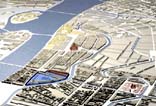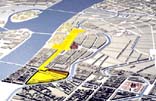|
|
|||||
| home > architetture | |||||
| ERIC
OWEN MOSS ARCHITECTS. Mariinsky Cultural Center/New Holland |
|||||
| ARCH'IT
presenta i progetti sviluppati dallo studio di Eric Owen Moss per il
Nuovo Teatro Mariinski e per il
New Holland a San Pietroburgo, che il pubblico italiano ha potuto conoscere
all'interno del Padiglione Russo in occasione della scorsa Mostra di
Architettura della Biennale di Venezia. La sezione files ospita, con
una introduzione di Paola Giaconia, un intervento del progettista: in
Agli scultori del ghiaccio,
Eric Owen Moss raccoglie la sue impressioni sulla storica città e riassume
le sue intenzioni relative alla proposta progettuale. |
|||||
| St.
Petersburg is not an assemblage of discrete buildings. Rather it is
a chronology of monumental spaces that sweeps one along from plaza and
canal to building and monument. Buildings originated in different eras
and were built in various styles. But the consistent lessons are scale
and power. There is no consigning the asymmetry of those public spaces
to a sedate conclusion. To architecturally intervene in the area is
to exploit its spatial message. The tradition of long diagonal views
and expansive public space is open ended. There is room for more. The reconstitution of New Holland is not merely a location for new building "events" in the historic center of St. Petersburg, but rather an attempt to understand the site as an extension of the existing organization of the historic district. The city’s historic center consists of a linear arrangement of the Winter Palace and Hermitage, Palace Square with Alexander’s Column, the Admiralty, and St. Issac’s Cathedral along a west-east axis. The grand tree-lined Konnogvardeiskiy Boulevard continues west from these landmarks and terminates at New Holland, making it a pivotal site in St. Petersburg that can both continue the cultural corridor as well as create new ones. |
[17jan2003] | ||||
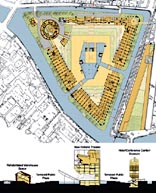 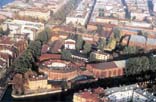 |
SITE.
Circumscribed by canals, New Holland’s triangular site is approximately
74,000 square meters. Old brick warehouses, long used for shipping,
define the east and west edges in a construction language already familiar
to the city center. A brick circular structure, formerly a prison, occupies
the northwest corner. The proposal for New Holland is to sequester the
cultural facilities behind the newly rehabilitated brick structures. The northeast corner of New Holland will open to pedestrians moving west from Palace Square, or from the subway exit just east of New Holland. These pedestrians will proceed across bridges into New Holland, through a large exhibit hall on the corner and into the open-air performance space beyond. The brick buildings on the edges of the canals are to be rehabilitated for offices, retail, restaurants, classrooms, and workspaces for the arts. Due to the poor condition of the warehouses, only the brick shells are saved and restored. The organizational principles of the new infill structures are based on the pre-existing structural grid. The resulting buildings have a double face – open to the canals and city beyond, and to the public plaza where dance, music and impromptu performances will be held. |
|
|||
 NEW HOLLAND HOTEL/CONFERENCE CENTER/MUSEUM. A new mixed-use structure on the north edge of New Holland completes the built triangle. The structure matches the width and structural grid of the warehouses. It is designed to combine hotel rooms, restaurants and an exhibition center that will display technical products from around the world. This exhibit space may be used for a single show, or sub-divided for multiple exhibits and conferences. At the street level are lobbies for hotel and exhibit center along with the entrance to a new art museum installed in an old submarine testing pool below the hotel. The museum will include a collection of contemporary art works. In contrast to the brick of the existing structures, the hotel center is primarily glass with an undulating roofline that will offer spectacular views of the city and Gulf of Finland beyond. |
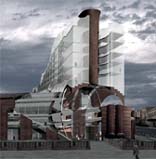 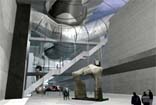 |
||||
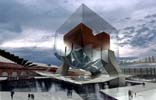  |
 THE NEW HOLLAND THEATER. The plaza internal to the New Holland site has space for 30,000 concert goers. The center of the plaza holds a large pool, once used by ship builders to re-float their boats. That pool will remain in its original shape, connected to the canals that surround the site. Against the north edge of the pool, an outdoor stage will be constructed with production and support facilities housed below. Above the water are 5,000 temporary theatre seat supported on removable steel structures. Above the stage and seat is a floating glass enclosure – a great spatial promenade in the air, with concourses that lead to the new 700-seat concert hall within. The original structures are brick; the new hotel is glass; and the concert hall combines the two materials. SKYLINE. The elevations of the new hotel, and the raised glass promenade and concert hall are visible from Palace Square to the east and will punctuate the western skyline of the city. On a site-specific level as the primary venue for the White Nights Festival and on an urban level as a continuation of monumental spaces and buildings, New Holland will become an important new cultural destination in St. Petersburg. |
 |
|||
| ERIC
OWEN MOSS ARCHITECTS. Mariinsky Cultural Center/New Holland |
|||||
| location: St. Petersburg, Russia developer: Samitaur Constructs principal architect: Eric Owen Moss project team: Scott Nakao, Dolan Daggett, Eugene Slobodyanuk, Raul Garcia, Jose Herrasti, Sophie Frank, Emil Mertzel, Eric McNevin, Chuck Hellwig, Elena Andrews, Sharon Judelman, John Bencher, Paul Groh, Farshid Gazor, Reza Bagherzadeh, Pierpaolo Granata, Paolo Volpis, Brooke Luddock, Yaron Naim, Oliver Dering project: 2001 |
|||||
|
Eric Owen Moss
started his office in 1973 in Los Angeles, California, having received
his B.A. (English) from UCLA in 1965, M. Arch. in 1968 from UC Berkeley,
and M.Arch. in 1972 from Harvard's Graduate School of Design. He is
best known for reinventing spaces for commercial uses and performing
arts facilities, breathing new life into a marginal area in the celebrated
sequence of buildings in Culver City's Hayden Tract. Named "top architect
of a new generation" and "the jeweler of junk" by eminence gris Philip
Johnson, Moss pays careful attention to detail, both in terms of the
way things are put together, and the materials they are made from.
As N.Y. architect Charles Gwathmey stated in the 1999 awards ceremony
of the American Academy of Arts and Letters, "the architecture of
Eric Owen Moss is highly original. The forms and spaces embody a poetic
vision, enriched by a rigorous tectonic commitment. The buildings
are resonant and inspiring, and through their inventive presence,
establish a sense of pertinent place." The work includes university
facilities, office buildings, corporate headquarters, cultural institutions,
theaters, galleries, exhibition spaces, restaurants, urban public
space, housing, and private residences. Moss received the AIA/LA Gold
Medal in 2001, and his work has received numerous Progressive Architecture,
AIA, and AIA/LA design awards and has been widely published. He has
taught at all the leading U.S. schools of architecture, including
SCI-Arc, Harvard, Yale, Rice, Columbia, UCLA, and USC and is currently
director of SCI-Arc, Southern California Institute of Architecture. |
|||||
|
>
ERIC OWEN MOSS ARCHITECTS |
|||||
|
Per
candidare progetti laboratorio
|
|||||
